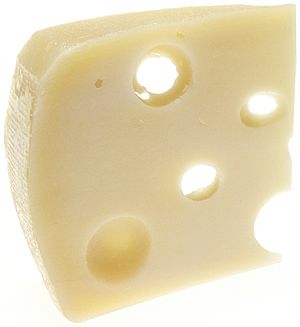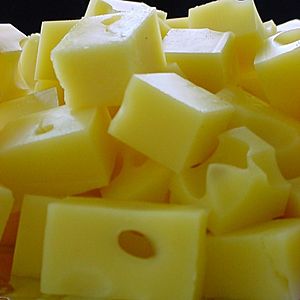Swiss cheese facts for kids
Swiss cheese is a type of cheese that is well-known for having holes, which are also called "eyes." This group of cheeses got its name because they look a lot like the traditional Emmental cheese from Switzerland. It's a popular choice for sandwiches and snacks around the world.
How Swiss Cheese Gets Its Holes
Swiss cheese is famous for its unique holes. These holes are not just for looks; they are created by tiny living things called bacteria during the cheese-making process. One special type of bacteria, called Propionibacter, plays a key role.
Here's how it works:
- Other bacteria in the cheese first turn milk into lactic acid.
- Then, Propionibacter bacteria come along and eat this lactic acid.
- As they eat, they produce carbon dioxide gas.
- This gas slowly forms small bubbles inside the cheese as it ages. These bubbles are what become the holes.
The holes in Swiss cheese are known as "eyes." If a Swiss cheese does not have any holes, it is called a "blind" cheese.
Why Bigger Holes Often Mean Better Taste
You might notice that some Swiss cheeses have larger holes than others. Generally, Swiss cheeses with bigger "eyes" are thought to have a better taste. This is because the same things that help make the holes larger also help to make the cheese taste better.
These important factors include:
- Longer aging time: The cheese is given more time to develop its flavor and holes.
- Higher temperature: The cheese is kept at a warmer temperature during part of its aging process.
Both of these conditions allow the bacteria to work more effectively, creating more gas and a richer flavor. So, next time you see a slice of Swiss cheese with big holes, you'll know it's a sign of good taste!
Other pages



